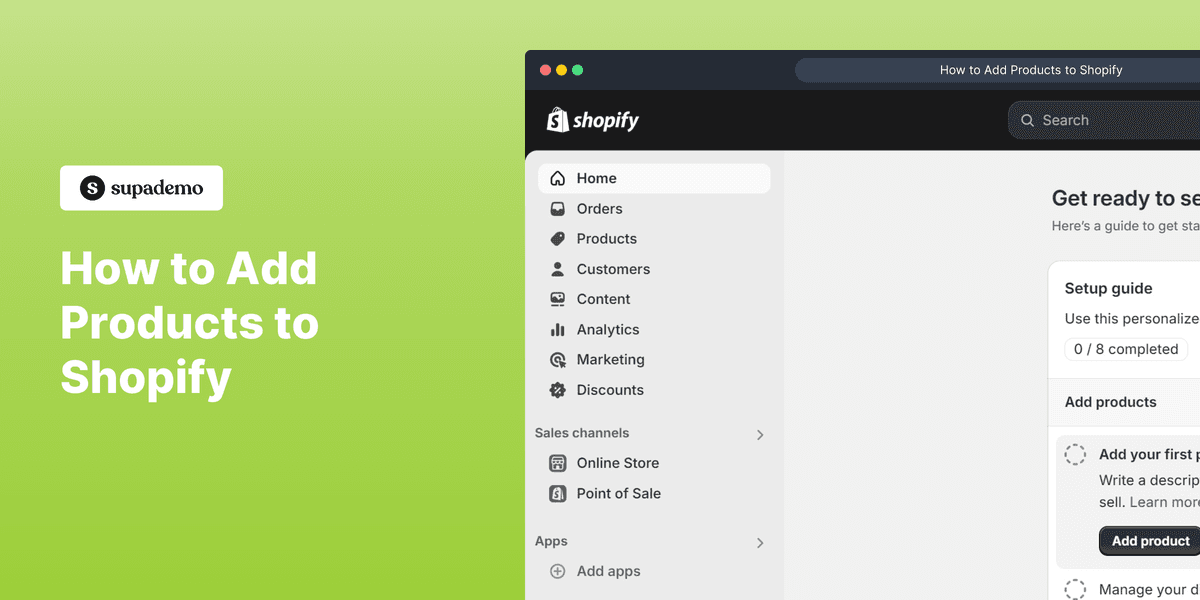What Is a Workflow? A Beginner's Guide to Understanding & Optimizing Work


The success of a business rests on a firm foundation and a well-structured system. A crucial aspect of this system is centered around the business's workflow and its efficient establishment. A proper workflow is essential for the smooth functioning and efficiency of a business. So, what precisely is a workflow, and why is it of utmost importance for a business?
If you're not familiar with the term and its concept, there's no need to worry because we have you covered. In this beginner's guide, we will offer in-depth knowledge about workflows and their various aspects. Moreover, we will introduce you to outstanding tools such as Supademo that can help you establish strong workflows for your business.
Let's get started!
Exploring workflow: What is it and how does it bring value to your business?
Prior to establishing your business, it is essential to grasp several key aspects that ensure a successful beginning. One crucial aspect to understand is the concept of workflow. As previously mentioned, a business cannot function without a well-defined workflow. This is because a workflow provides the framework for organizing tasks in a specific sequence to accomplish desired goals.
In simpler terms, a workflow represents a series of activities performed in a prescribed order to achieve a goal or complete a task. These activities are often repetitive and serve a consistent purpose. Workflows are established based on the goals or requirements that drive their existence. It's important to distinguish workflows from processes, as processes encompass broader concepts involving more extensive information and data, while workflows specifically focus on delineating a sequence of tasks.
Let's consider another example to illustrate the concept of workflows. Imagine a restaurant that wants to introduce a new dish to its menu. The goal here is to add a delicious and popular item that will attract more customers. In order to achieve this, the workflow would involve several steps. First, the chef would create and test different recipes to come up with the perfect dish. Once the recipe is finalized, the ingredients needed for the dish would be identified and procured. Then, the kitchen staff would be trained on how to prepare and present the new dish.
Finally, the marketing team would promote the new addition through various channels to inform customers about the special offering. This entire sequence, from recipe creation to promotion, represents the workflow involved in adding a new dish to the menu.
By understanding and implementing workflows, businesses can ensure that tasks are organized, coordinated, and executed efficiently, leading to improved productivity and better outcomes. Workflows are versatile and can be applied across different industries and functions, enabling smooth operations and effective goal achievement.
Now, let's explore how workflows can benefit your business
Getting rid of superfluous tasks: By utilizing workflows, tasks that are redundant or do not make a significant contribution to the overall goals can be identified and eliminated, thus getting rid of unnecessary responsibilities and improving operational efficiency.
Simplifying task delegation: Workflows play a vital role in simplifying task assignment and establishing accountability within the team, guaranteeing that each task is appropriately assigned to the designated individual and completed within the predetermined timeframe.
Optimizing work processes: By adhering to clearly defined workflows, organizations can enhance their operational patterns, resulting in heightened efficiency and productivity levels.
Enabling efficient time management: By utilizing workflows, businesses can shorten processing periods, allowing for time savings and faster task completion.
Establishing and documenting a workflow: Creating well-defined workflows is crucial for the success of most business operations, as it helps mitigate errors and monotony that may arise from repetitive tasks. Fortunately, modern tools and software can automate these processes, reducing the potential for mistakes. In the following discussion, we will delve into effective methods of creating and designing workflows, but first, let's establish the importance of this practice.

Here are the key considerations while developing a workflow for specific purposes
Assessing available resources: To construct a streamlined and dependable workflow, the initial phase involves comprehending the existing resources at your disposal and recognizing any additional resources that might be necessary. For instance, if the objective is to establish a customer feedback portal to handle complaints, it is essential to ascertain whether a tech team is already in place to assist with the portal setup.
In the absence of such a team, it would be crucial to recruit one. This example underscores the significance of acquiring the requisite technical, human, and material resources prior to embarking on workflow development.
Establishing well-defined objectives: It is vital to have a clear and precise understanding of the objectives you aim to accomplish through your workflow. This clarity enables the determination of the sequential order of tasks required to achieve those goals. Building upon the previous example, imagine that you have successfully constructed the customer feedback portal and have received feedback encompassing complaints, product inquiries, and order-related problems.
To address these specific issues, you intend to direct the feedback to Teams A, B, and C, respectively. By explicitly defining your goals, you can create more intricate yet efficient workflows that align with your objectives.
Implementing task delegation and accountability: After identifying the available resources and setting clear goals, the next crucial step is to allocate roles and responsibilities. This involves task delegation and establishing transparent lines of accountability within the workflow.
By assigning specific responsibilities to individuals, you can easily track progress and address any potential issues that may arise. Clearly defined roles also promote transparency and enable employees to have a better understanding of their duties.
Create a visual representation of the steps: Visualizing your workflow is consistently advantageous. Flowcharts provide a superb means of illustrating workflows, demonstrating the order of tasks and their interdependencies. Elaborate flowcharts containing explicit instructions are commonly known as workflow models. After identifying all the essential steps and tasks, envision the entire process and construct a workflow model.
Numerous tools, including Supademo, are accessible, offering user-friendly functionality alongside professional features. Supademo is a demo software that aids in recording comprehensive guides by monitoring mouse movements. It serves as an outstanding tool for visualizing your workflow and facilitating its sharing with others. Here's an example:
The primary purpose of this step is to get a holistic view of the workflow, ensuring that no steps or details have been missed.
Conduct a thorough testing of the workflow: After gathering all the necessary resources, tasks, and roles, it becomes essential to validate your workflow. Put it into action on a smaller scale, involving a dedicated team, and observe its real-time performance.
Engaging your team members in the testing phase enables you to gather valuable feedback and make any required adjustments to the workflow. Once you have thoroughly tested and refined it, you can confidently proceed with implementing the workflow on a larger scale.
Provide training to your team: Regardless of whether the workflow is partially or fully automated, your team plays a crucial role in its success. To effectively implement the workflow, it is essential to provide comprehensive training to your team members, ensuring that they fully comprehend their roles and responsibilities. Address any questions or concerns they may have, as some team members may find it challenging to adapt to new methods due to their familiarity with previous approaches.
Training programs and visual aids, such as Supademo, can be immensely beneficial. Supademo allows you to review and record the workflow, tracking mouse movements and generating automated, editable, and shareable step-by-step interactive demos and guides. These guides can serve as training manuals for your team members.
Initiate the implementation of the workflow: At last, the moment has arrived to put your workflow into practice. Start by implementing it within a smaller team and closely observe its performance in real-world scenarios. Once you are content with the outcomes and confident in its seamless operation, you can progressively expand its implementation on a larger scale.
However, it is crucial to maintain continuous monitoring and regulation of the workflow to sustain its efficiency and ensure its ongoing relevance.
Ways to optimize your workflow
Now that you understand what workflows are, their benefits, and how to create them, let's explore a few tips and strategies to further optimize your workflow and maximize its potential.
Prevent overcrowding: Avoid overloading your workflow by attempting to include every single task within a single process. Instead, create distinct workflows for different requirements, such as hiring, onboarding, and new employee training processes. This approach ensures clarity in task sequencing, accountability, and a deeper comprehension of each individual process.
Adopt automation: Manual documentation can be a laborious and error-prone task, particularly as your workflow grows more intricate. Embracing automation with the help of workflow management software and other tools enables you to establish digital workflows, mitigating the risk of errors and providing several additional advantages. These benefits include enhanced efficiency, time savings, and the ability to create dynamic processes.
Enable seamless integration with other tools: By integrating your workflow software with other tools, you can streamline processes and facilitate smooth data exchange among different systems. For instance, integrating your workflow software with HR tools like time tracking or payroll systems, or with sales management platforms, can enhance implementation and significantly improve overall efficiency.
Actively seek feedback: Gather feedback from your engaged employees and customers who interact with the workflow. Their input can offer valuable insights into areas that can be improved, ensuring the ongoing relevance, efficiency, user-friendliness, and ultimately, the profitability of your workflow.
Set up a data bank to centralize information: Establishing a centralized data repository enables you to store essential information, including inventory, customer details, and product information. This ensures efficient access to necessary data at any point in the workflow, minimizing errors and saving valuable time. With organized information readily available, workflow speed and accuracy can be significantly enhanced.
In conclusion
Workflows serve as fundamental pillars for successful business operations. By adhering to the aforementioned steps and implementing optimization strategies, as highlighted earlier, you can establish efficient and dependable workflows for your business.
Utilizing demo software like Supademo can prove to be an invaluable tool throughout this journey, aiding in the visualization, documentation, and seamless sharing of your workflows.
Begin constructing your business's workflow guides today with Supademo and unlock the full potential of your operations!

Justin James
Justin is a growth intern focused on content generation and marketing. He's passionate about making an impact across various startup roles.






